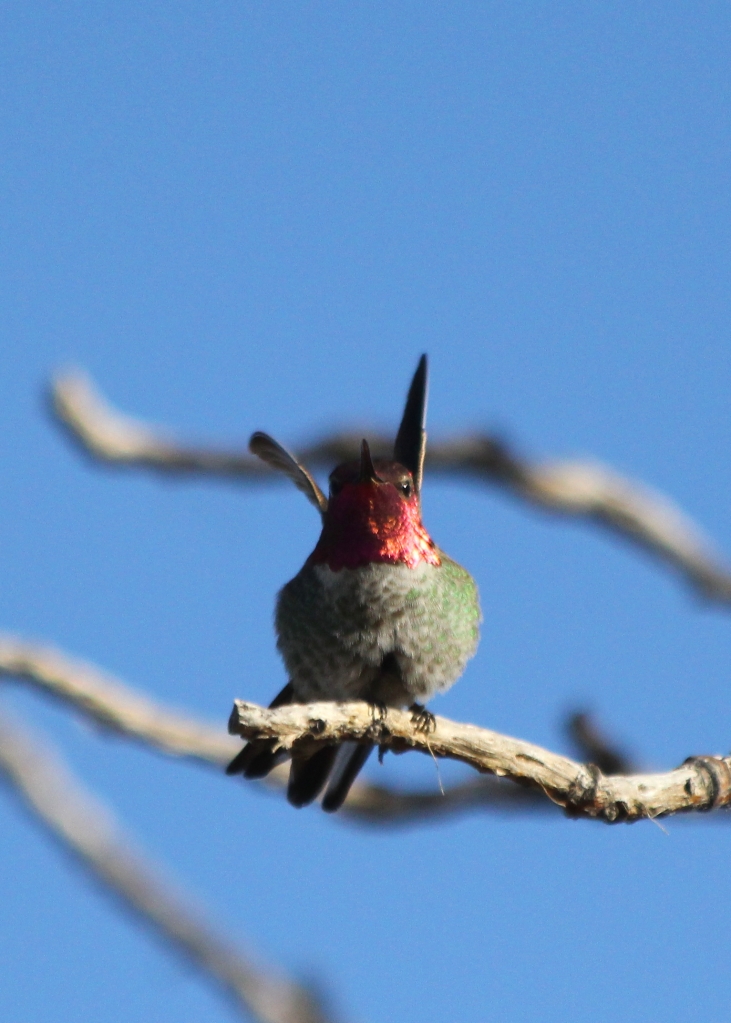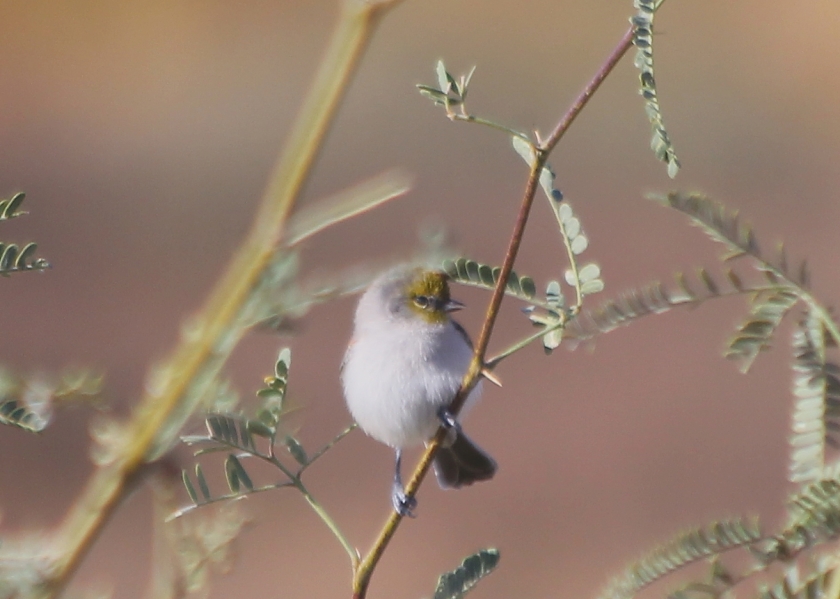The idea for this blog was born in Tucson, Arizona. After a trip there in April, 2014, we desperately wanted a camera to capture some of the moments we were experiencing in the field. Within a week of returning home from that trip we purchased a camera, and a week after that we wrote our first blog post. So when we returned to Tucson to visit Sarah’s sister, Kate, and her fiancé, Nick, for Thanksgiving, it was like this blog was returning to its roots.
Southeast Arizona might be the best birding location in the United States. It’s the only place where the habitats of the Rocky Mountain and the Sierra Madre Occidental cordillera meet – and as a result, birders can see species from both regions. In addition, the region around Tuscon is populated with isolated mountain ranges, known as “sky islands” which reach reach elevations of over 10,000 feet. These elevation changes result in different habitats stacked on-top of one another, so that birds can migrate by changing elevation instead of latitude. The long and the short of it is that there are a lot of birds around, the birds are particularly cool, and many of the birds are found nowhere else in the U.S.
We started out by birding in Kate and Nick’s neighborhood. One of the first birds we saw was the White-crowned Sparrow. This is a bird we see occasionally in the Northeast during migration, but we have never seen so many as we did in Tucson in November.
Both the White-crowned and Lark Sparrows loved the seeds leftover in the garden. The Lark Sparrow is only found in the western U.S., so seeing so many of them was a treat.
Perhaps the most common bird in the yard, after the sparrows, was the colorful Vermilion Flycatcher. These birds are only found in the Southwest and the adult males have brilliant red undersides. Even the immature males are pretty cool.
In the Northeast, we only have one species of hummingbird that occurs regularly. In Tucson, there are 14. Most of these species pass through during migration, but several species, including Costa’s Hummingbirds and Anna’s Hummingbirds stick around all year. Tim chased a male Anna’s Hummingbird around the yard for a while to get these shots.
The backyard birding in Tucson is pretty darn good, but another neighborhood hot spot was about to take our birding to another level. Not far from Kate and Nick’s place is an abandoned aggregate mine known as “The Pit”. It is essentially a series of wide excavations approximately 30 feet deep dug over a 70 acre area. Some parts of The Pit are next to alfalfa fields and the irrigation runoff collects in the bottom, forming a desert oasis. We’d heard many interesting things about The Pit and were very excited to check it out.
The short walk to The Pit also yielded quality birds, like this Say’s Phoebe (LL) perched on horseshoe sculpture in a neighbor’s yard.
Or this American Kestrel perched on a telephone wire. The American Kestrel is the smallest falcon found in North America (about the size of a Blue Jay). In most of North America, Kestrels have blue-gray wings and bright red backs, but the Southwestern ones are a bit more subdued to blend into their desert environs.
Contrary to what Tim feared before visiting, Tucson is not covered in manicured lawns and golf courses (that is Phoenix) – most of the landscaping reflects the desert environment. Mountains are visible just about everywhere you go in town. This is a shot of the walk from Kate and Nick’s to The Pit with the Tucson Mountains in the background.
On the way to The Pit, one can see the Mission San Xavier del Bac, finished in 1797, which makes it the oldest European-built structure in Arizona. The original mission dates from 1692.
Suddenly, the ground disappeared in front of us, and we found ourselves on the edge of The Pit.
We could immediately feel that we were in a special (and some say sacred) place. These pits were dug on a site that was inhabited by the Hohokam people hundreds of years ago, and the eroding walls of The Pit are filled with thousands of shards of their pre-Columbian Native American pottery. In some areas, you could easily see dozens of shards protruding from the dirt, and each piece seemed to be painted with a unique red or black pattern.
We could also see a flurry of bird activity. One of the first birds we saw on the edge of The Pit was this male House Finch, which is native to the western U.S., but has invaded the East to become a common species there.
Once we descended into The Pit, we saw Rock Wrens hopping about on the sloping walls.
Over the ponds, Vermilion Flycatchers were darting around catching insects over the water. Most of the birds we saw were immature, like this one.
But occasionally, we got a view of the adult male, which is a real treat.
In one of the deepest parts of The Pit, we got a brief glimpse of one of our favorite birds of Arizona, the Gamble’s Quail. But just as soon as we spotted them, they found cover in the brush. They need to be wary, as there are lots of hawks and coyotes in the area. Tim was able to get this shot off, just before they disappeared.
Looking up, we realized that our chance at a good photograph had been spoiled by this Red-tailed Hawk (thanks buddy).
As we stood on the ledge of another pond, we looked across and saw two hawks chasing down the same prey. We locked our binoculars on them and saw they were both chasing a Greater Roadrunner. We rooted for the Roadrunner’s escape, but in a moment they struck it down and everyone disappeared behind a bush. We were stunned for a second as the movement stopped. Sarah eventually made her way across the pond and found a pile of perfectly clean, beautiful black, white and iridescent green Roadrunner feathers.
We’d spent hours wandering around the pit, and decided it was time to return home to eat some delicious Thanksgiving leftovers. One of the last birds we saw in The Pit was one of the signature birds of the desert Southwest, the tiny and adorable Verdin.
But this was just the beginning our of birding in Southeast Arizona. Stay tuned for Nerds in the Desert, Part II: The Santa Rita Mountains and the Sulphur Springs Valley!
Here are the lists:
Kate and Nick’s – November 26, 2015 – 9:29 am – 11:07 am
House Sparrow
Say’s Phoebe
Mourning Dove
Feral Pigeon
European Starling
Lark Sparrow
Inco Dove
Great-tailed Grackle
Eurasian Collared Dove
Curve-billed Thrasher
Gila Woodpecker
Yellow-rumped Warbler
Vermillion Flycatcher
House Finch
Verdin
Anna’s Hummingbird
White-crowned Sparrow
The Pit – November 27, 2015 8:17 am – 12:15 pm
White-crowned Sparrow
Mourning Dove
Feral Pigeon
Great-tailed Grackle
American Kestrel
Vermillion Flycatcher
House Finch
Say’s Phoebe
American Coot
Northern Shoveler
Gadwall
Yellow-rumped Warbler
Vesper Sparrow
Tree Swallow
Rock Wren
Red-tailed Hawk
Black-crowned Night-heron
Northern Harrier
Verdin
Abert’s Towhee (LL)
Northern Flicker
Gamble’s Quail
Greater Roadrunner
Ruby-crowned Kinglet
Mallard
American Wigeon
Pied-billed Grebe
Cinnamon Teal
Great-blue Heron
Lesser Scaup
Ring-necked Duck
Black Phoebe (LL)
Lark Sparrow



















Looking forward to: Tucson Part 2 AND Costa Rica. Get busy!